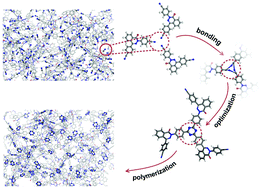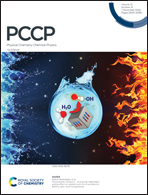A modelling algorithm for amorphous covalent triazine-based polymers†
Abstract
Rational and purposeful designs of amorphous materials with desirable structures are difficult to implement due to the complex and unordered nature of such materials. In this work, a modelling algorithm was proposed for amorphous covalent triazine-based polymers to construct atomistic representative models that can reproduce the experimentally measured properties of experimental samples. The constructed models were examined through comparisons of simulated and experimental properties, such as surface area, pore volume, and structure factor, and further validated by the good consistency observed among these properties. To assess the predictive capability of the modelling algorithm, we used a new covalent triazine-based polymer and predicted its porosity by constructing a simulated model. The predicted results on the surface area and pore volume of the simulated model were quantitatively consistent with the experimental data derived from the experimentally synthesized sample. This consistency reveals the predictive capacity of the proposed modelling algorithm. The algorithm could be a promising approach to predict and develop advanced covalent triazine-based polymers for multiple applications.



 Please wait while we load your content...
Please wait while we load your content...